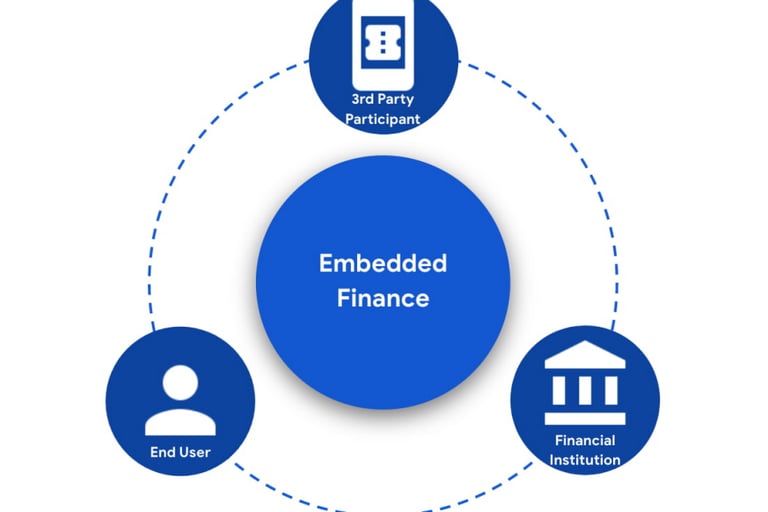"Embedded Finance: The Future of Seamless Financial Integration"
By embedding finance into everyday tools, businesses can create new revenue streams, improve user engagement, and offer more personalized services. The importance of embedded finance lies in its ability to drive financial inclusion, reduce friction in financial transactions, and enable businesses to better meet the needs of their customers in a rapidly evolving digital world. As it continues to grow, embedded finance is poised to revolutionize the way we interact with money, offering more tailored and accessible financial solutions.

How the rise of Embedded Finance transforming industries
What is Embedded Finance?
Embedded finance also sometimes known as ‘Embedded banking’ is the seamless integration of financial services into a traditionally non-financial service. Financial services may be 'embedded' within customer-facing digital platforms using Embedded Finance Infrastructure. This enables the customer to make cashless payments in-app or in context without switching to another application. This tremendously reduces the hassle for the customer thereby increasing the customer lifetime value which helps in achieving brand loyalty.
Some of the most well-known examples of Embedded finance are Amazon EMI loan options,Klarna and AfterPay Embedded finance isn’t just about customer convenience but understanding the customer behavior through spending habits and needs by analyzing the enormous amount of data generated on daily basis. This can be easily used to drive the future business development
Embedded financing enables you to pay for items online without giving your bank account information or to take out a consumer loan via digital platforms outside of banks, among other things. Until recently, if a company wanted to provide financial services, it had to develop its own FinTech wing. This required enormous investment, took years to create, and took even longer to start yielding profits. Embedded Finance Infrastructure lowers the barrier for digital platforms to deliver financial services to their clients natively (by 10x). Lot of companies are considering to offer embedded finance as a key monetization lever. Embedded Finance allows customers to have 'native' FinTech experiences within non-FinTech digital channels that are closest to them.
Market share and Valuations
With the embedded finance rapidly taking over the fintech industry, it presents an estimated $7 trillion market opportunity globally by 2030, twice the combined value of the world’s 30 biggest banks right now. According to Juniper Research, the market value of Embedded Finance will exceed $138 billion in 2026 from just $43 billion in 2021.
Embedded finance has played a vital role in driving adoption of digital payments in India. UPI which has been undisputedly the preferred choice of payment mode, clocked 5.4 bn in March- 22. The spike has been due to increase in peer to merchant transactions. This suggests the imperative role UPI will play in financial inclusion by bringing the tier-3 and beyond cities into digital ecosystem.
Top use cases of Embedded Finance
Listed below are common uses of how to embed financial tools into your business:
B2B
Innumerable non-financial companies want to offer financial services to its customers to retain their customer and offer an exceptional user experience. This is where the embedded finance becomes imperative to build brand loyalty.
Online marketplaces such as Amazon and other service providers such as ride-hailing app offer financial products to its customers within the app without migrating to third party applications. In India, UPI as a payment option has been integrated within applications to offer paymentsservices such as Amazon, WhatsApp and Google.
Buy Now, Pay Later
Buy now, Pay Later systems empower the modern shoppers by giving them a new line of creditand enable them to buy from a wide range of products and choose to pay later through interest free EMI. This provides an impetus to the sales and increases the profit margins of the retailers.
BNPL is another widely used concept of embedded finance that redirects consumer to a third party fintech provider. Thus have emerged as preferred choice over credit cards due to frictionless payment experience, transparency and affordability.
Credit Scoring on Banking Websites
Offering your customers, a free credit score calculator on banking websites is kind of embedded finance where the banking/lending businesses enable the customer to make an informed decision by monitoring their credit score
Automotive
Financing and Insurance are the key profit drivers of the automobile industry. These businesses offer a wide array of funding and insurance options to the customers. With embedded finance, better customer offering, guaranteed engagement and brand recognition is possible.
Insured Rides
Ride hailing apps such as Uber are offering insurance policies on their platform and trying to make the most out of embedded finance. Bringing the factor of safety while travelling, Uber is offering insurance at nominal premium to its riders based on the driver’s rating, attitude etc. These kind of use cases of embedded finance help the non-financial companies to build a long lasting customer relationship.
Booking the parking slots
Google Maps has integrated the capability to book a parking slot closest to your destination street and pay within the app using Google Pay. The solution makes the payment process easier and faster than the manual process of paper bills. There are numerous use cases where embedded finance can be integrated. However, these use cases give you an idea about the versatility of the concept and its growing trend.


Contact us
Whether you have a request, a query, or want to work with us, use the form below to get in touch with our team.




